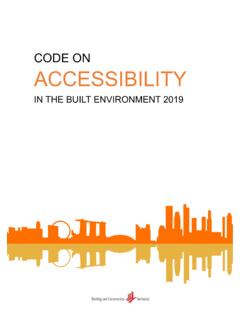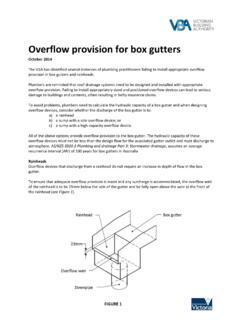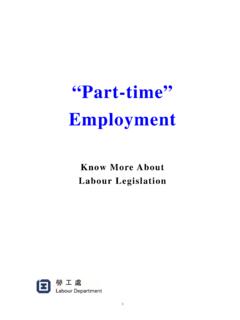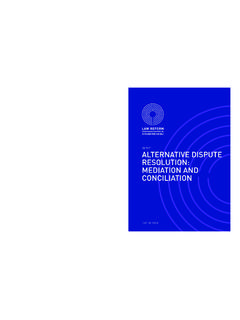Transcription of Cop on Vehicle Parking Provision in Development Proposals ...
1 Code of PracticeCode of PracticeDevelopment & Building Control 2019 EDITION _____ Code of Practice for Vehicle Parking Provision in Development Proposals - 2019 Edition CODE OF PRACTICE FOR Vehicle Parking Provision IN DEVELOPMENTS (2019) Purpose This Code of Practice (COP) outlines the requirements of the Parking Places ( Provision of Parking Places and Parking Lots) Rules ( the Rules ) for Provision of Parking places and lots. It also cites examples of good practices in the industry. Diagrams, sketches and photographs are used to illustrate some of the Parking requirements and practices. The Rules stipulates the following: a) The number of Parking lots to be provided for various uses; and b) The minimum dimensions of such Parking lots, circulation aisle, access ramps and other details on the arrangement of the Parking place and lots.
2 C) The conditions, include payment of money, under which the Land Transport Authority (LTA) may grant a waiver on the Parking Provision . In using the information in this COP, users should always make reference to the Rules. The Authority reserves the right to impose conditions on individual Development proposal not covered in the COP, on a case-by-case basis. _____ Code of Practice for Vehicle Parking Provision in Development Proposals - 2019 Edition Introduction There are two key considerations a Qualified Person (QP) must take when designing a Parking place. The first is the number of Parking lot requirement and the second is the layout of the Parking place.
3 The Parking place layout should be safe and functional to facilitate smooth and convenient passage for motorists. QPs should design the Parking place with this in mind. While the minimum dimensions of a Parking place stipulated in the Rules meet the lot and manoeuvring requirements of most vehicles in Singapore, Provision in excess of the minimum dimensions may be made to further enhance the layout of the Parking place. Where land comes at a premium and competing uses in the Development constraints the Provision of conventional Parking lots, mechanised Parking systems offer a feasible option for providing Parking lots.
4 These systems typically operate either on a stacking basis or a storage basis. Car lifts replace the conventional ramp system for access to the Parking place. Mechanised Parking systems can be incorporated in a Parking place as long as they meet the requirements stipulated in the Rules. QPs must give due consideration to the safety of motorists, pedestrians and vehicles in the design of mechanical Parking systems, as it involves heavy moving machinery, to avoid harm and damage to property. _____ Code of Practice for Vehicle Parking Provision in Development Proposals - 2019 Edition Disclaimer The contents of the Code of Practice (COP) are subject to revision from time to time.
5 A circular will be sent to inform the professional organisations of changes. Users are advised that this COP is a guide to the Rules. Where there are ambiguities or perceived conflicting requirements, the Rules will have precedence. Users are also advised to consult the LTA at as early a stage in their Development as possible to ensure that the needs of the developer are met holistically. While every endeavour is made to ensure that the information provided is correct, the Authority disclaim all liability for any changes or loss that may be caused as a result of an error or omission in the COP.
6 _____ Code of Practice for Vehicle Parking Provision in Development Proposals - 2019 Edition CONTENTS Chapter Page 1 Provision of Parking Lots 6 2 Parking Layout Dimensions 13 3 Mechanised Parking Systems & Car Lifts 39 4 Good Practices 48 5 Plan Submission Procedure 65 Appendix A Table 1 Range-Based Parking Provision Standards Table 2 Bicycle Parking Requirement Matrix B Types of Development Exempted from deficiency charge C Samples of Computation for Parking Requirement D Types of developments exempted from obtaining Vehicle Parking clearance _____ Code of Practice on Vehicle Parking Provision in Development Proposals -2019 Edition P a g e | 6 CHAPTER 1: Provision OF Parking LOTS Overview The Parking Places ( Provision of Parking Places and Parking Lots) Rules stipulate the Parking Provision standards.
7 This chapter illustrates the method adopted for the computation of the required number of Parking lots a Development should provide. Parking Provision The Parking Provision standards for the various Development uses are given in Appendix A. Parking requirements are usually based on the quantum of the gross floor area or the number of units of the Development uses. Where a Parking standard is not available for a proposed use, the QP may carry out his own assessment on the Parking requirement and submit it with justification to the Authority for approval. This assessment should include the following information, where relevant: Visitorship / staff strength and mode share; Car / motor-cycle Parking occupancy data of existing / similar developments; Parking demand management measures ( Parking rates, allocation of Parking lots); Plans to improve first-last mile connectivity, travel and Parking demand measures ( shuttle bus services, car-pooling programmes, telecommuting initiatives); Explanation of operations and/or operational needs of Development .
8 _____ Code of Practice on Vehicle Parking Provision in Development Proposals -2019 Edition P a g e | 7 Zonal Standards Singapore Island is divided into four (4) zones. Zone 1 comprises of the city (Restricted Zone) and the Marina Bay. Zone 2 refers to the areas within 400m radius from Rapid Transit System (RTS) stations outside Zone 1. Zone 3 is the rest of the island, excluding Zones 1, 2 & 4. Zone 4 refers to car-lite precincts. The boundaries of Zones 1, 2 and 4 can be found in OneMap. Car Parking The Rules allow for a range-based Parking Provision for developments island-wide. Developers may propose a Parking Provision within the lower-bound and upper-bound, without the need for additional approval from the Authority.
9 Residential developments that provide fewer car Parking lots than the number of dwelling units will have to inform buyers of the Parking situation upfront in the Option to Purchase and Sales & Purchase Agreement. Motor-Cycle Parking Developers are required to provide motor-cycle Parking lots within their developments to prevent indiscriminate Parking of motor-cycles on walkways and carriageways. Building owners are also encouraged to allow despatch riders to park temporarily at their loading/unloading bays to facilitate delivery by motorcycles. _____ Code of Practice on Vehicle Parking Provision in Development Proposals -2019 Edition P a g e | 8 Loading bays, coach and other heavy Vehicle Parking facilities There are requirements for loading bays, coach, bus and lorry Parking for Office, Retail, Hotel, School, Industrial and Warehouse uses respectively.
10 Designers shall ensure that such facilities are adequately and appropriately provided so that Parking of these vehicles do not overspill onto the nearby roads, causing disamenity to the neighbourhood. Although residential developments are not required to provide loading & unloading bays, designers should incorporate in their design sufficient area within the Development to facilitate house moving / delivery by heavy vehicles. Other than residential developments, if a premise is used for overnight Parking of heavy vehicles, the owner is required by law to apply for a licence from LTA.
















